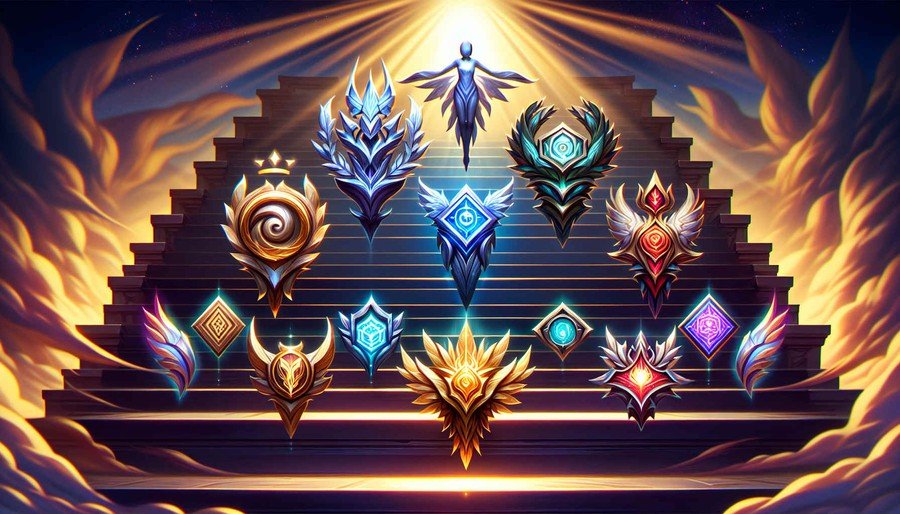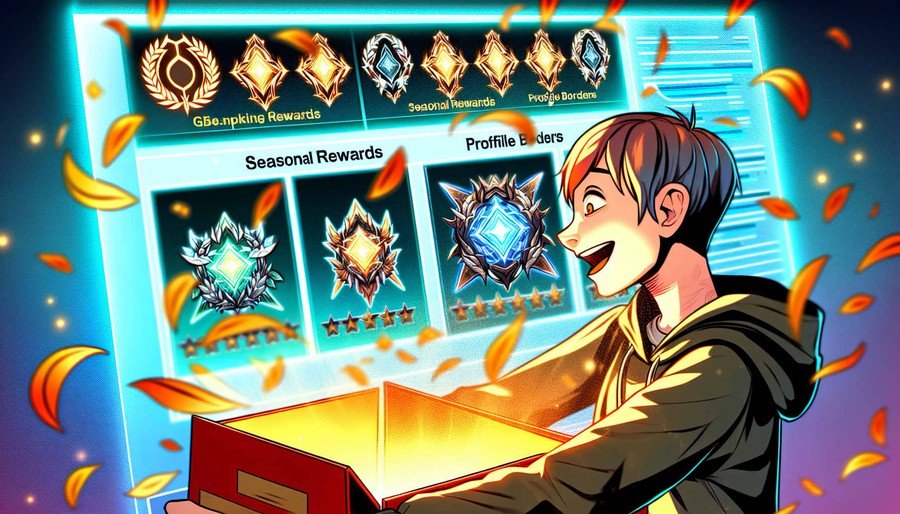Mastering Wild Rift ranks with wild rift boosting is essential for any competitive player. This guide dives straight into each rank’s specifics and outlines proven strategies to help you climb from Iron to Challenger efficiently. Get ready to elevate your Wild Rift status with insider tips and tactics.
Key Takeaways
Wild Rift ranks from Iron to the newest top tier Sovereign determine player status, with each rank divided into four divisions that require accumulating Ranked Marks to progress.
Effective climbing strategies include communication, proper champion selection, and enhancing map awareness to make smarter decisions in-game.
Placement matches are crucial in establishing your initial rank; they offer double Ranked Marks for wins without penalty for losses, making them a key focus for a solid start in the season.
Wild Rift Ranks Explained

Ah, the ranks! They are the essence of our experience in Wild Rift’s ranked play. Ranging from Iron to the coveted Challenger, each of the ten unique ranks signifies a player’s skill and commitment. Each rank, from Iron to Diamond, is divided into four divisions, IV to I, each requiring a specific number of Ranked Marks to progress. Wondering about the number of Ranked Marks required? The count differs, as follows:
Ad
Iron: 2 Ranked Marks
Bronze: 3 Ranked Marks
Silver: 4 Ranked Marks
Gold Rank: 4 Ranked Marks
Platinum: 5 Ranked Marks
Emerald: 5 Ranked Marks
Diamond: 6 Ranked Marks
Master: 6 Ranked Marks
Ad
Grandmaster: 6 Ranked Marks
Challenger: 6 Ranked Marks
But the challenge doesn’t stop there. As you climb higher, queue restrictions tighten to maintain competitive play. The highest ranks, Challenger and the newly added Sovereign, have the most stringent requirements and are reserved for the top players, their names showcased in the public leaderboard. But don’t worry, even if you’re starting out in Iron, you can still queue with friends up to Silver.
Rank Progression
Wondering about rank progression? Rank marks hold the answer. Each game you win earns you a Ranked Mark, bringing you closer to the next tier. But be careful, losing matches can result in the loss of Ranked Marks, and you could even face a regression to a lower division or tier. Hence, it becomes vital to maintain an impressive win-loss ratio. Consistent performance is your best friend on your journey up the rank ladder.
Remember, your rank progression is structured through earning Ranked Marks across the four divisions within each rank. This system allows you to track your advancement toward higher competitive tiers. Therefore, closely monitor your required rank marks and victory points as they pave the way to the next tier.
Seasonal Changes
Seasonal changes in Wild Rift can shake things up a bit. At the end of each Ranked season, there’s a reset, impacting aspects like rank and matchmaking. This reset might change your rank based on your final position. Rest assured, if your rank is Gold or below, you’ll generally kick off the new season from the same position.
Ad
These seasonal changes necessitate adaptation to new metas, as well as learning from previous seasons. So, stay flexible, keep yourself updated with the latest strategies, and you’ll be ready to face whatever the new season brings.
Tips for Climbing the Ranks in Wild Rift

Having understood the ranking system, it’s time to delve into some transformative strategies. Communication is key in this team-based game. Make sure to use pings judiciously to keep your team on the same page. If you’re the most experienced or highest-ranked player on your team, consider guiding your teammates as a shot caller. But remember, don’t overwhelm them; a confident leader inspires trust and cooperation.
Now, you’ve got the basics down, but to really excel in the ranks, you’ll need to delve deeper into the strategies of champion selection, map awareness, and teamwork. Prepared to ascend the ranks? Onwards!
Champion Selection
Champion selection can be a game-changer in Wild Rift same as for tft boosting. You need to understand various champions and roles to adapt to team needs and counter the opposition effectively. Suggesting champions that counter the enemy’s draft or complement your team’s composition can increase your chances of winning.
Also, consider using champion counters to gain an advantage in lane matchups. Certain champions are known to perform well against specific opponents. And don’t forget to consider early laning advantages or disadvantages when picking champions. A strong start can set the pace for the rest of the game.
Ad
Map Awareness
Enhancing gameplay also significantly depends on map awareness. It’s not just about knowing where everyone is; it’s about making key macro decisions. Maybe it’s securing objectives or pushing towers. Whatever it is, good map awareness can contribute significantly to achieving victory in a match.
Learning to read the map effectively takes time, but it’s worth it. Here are some tips to help you get started:
Regularly check the map and note the position of your team and the enemy.
Look for patterns and make strategic decisions based on the information you gather.
Pay attention to every bit of information, as it can give you an edge over your opponents.
Remember, practice makes perfect, so keep working on your map reading skills to become a better player.
Communication and Teamwork
Ad
In the world of lol wild rift, communication and teamwork are fundamental to success. To communicate effectively, use pings to share important information quickly without disrupting gameplay. Limit in-game typing to moments of low activity to avoid missing out on crucial gameplay actions.
And let’s not forget the power of positivity. Maintaining a positive attitude can boost team morale and soften the impact of mistakes during matches. Be clear about your preferred role and intended actions to prevent role confusion and ensure team synergy. If you’re queuing with friends, this can enhance communication and teamwork, potentially boosting your success in placement matches.
Placement Matches and Their Impact on Your Rank

Your initial rank in Wild Rift is significantly influenced by your performance in the first few ranked games, known as Placement Matches. These matches present a distinctive chance to shape your initial rank. You won’t lose any Ranked Marks, and you’ll receive two marks for each win.
Wondering how to leverage Placement Matches to your advantage? Here are some strategies that can help you kick off the ranked season with vigor.
Strategies for Placement Matches
Placement Matches are your chance to start the ranked season on the right foot. You won’t lose any Ranked Marks for losses, and you’ll earn two ranked marks for wins, providing a significant opportunity to boost your initial rank.
Ad
To maximize your success rate in ranked games, here are some tips to follow:
Prioritize playing champions you’re familiar with and those with high carry potential.
Report missing enemies to prevent surprise attacks and keep track of enemy summoner spell cooldowns to capitalize on advantageous situations.
Maintain a positive outlook and foster a learning mindset.
Aim for win streaks to build momentum and allow for quicker accumulation of Ranked Marks.
Following these tips will help you improve your performance and increase your chances of winning in ranked games.
Ranked Fortitude and Its Benefits

Ad
Enter Ranked Fortitude, a unique feature of Wild Rift’s ranking system. You can generate Fortitude by participating in matches, with the amount awarded based on match victories and achieving certain in-game milestones. Midway through your Fortitude bar, you’ll unlock Loss Protection, which prevents immediate loss of Ranked Marks.
But the benefits don’t stop there. Achieving full Ranked Fortitude grants you Loss Shields. These shields prevent the deduction of a Ranked Mark following a loss, safeguarding your rank progression. Pondering over how to earn or lose these valuable Fortitude points? Let’s explore!
Earning and Losing Fortitude
You can earn Ranked Fortitude points by:
Maintaining win streaks
Showing perseverance with an AFK teammate
Playing the assigned lane
Queuing up as auto-fill
Ad
Performing well in a loss
But beware, AFK behavior, frequent disconnections, and violations of the game’s code of conduct can result in loss of Fortitude points.
There’s also a tier-based cap on Ranked Fortitude, and reaching it can offer benefits like storing up to two Loss Shields that can convert into extra Ranked Marks. So, to safeguard your Ranked Fortitude and protect against rank loss upon defeat, it’s crucial to avoid negative behavior during gameplay.
Character Bans and Their Influence on Ranked Games
Character bans add a layer of strategic depth to Ranked games not present in normal games. Each team in a Wild Rift ranked match can claim a total of three character bans, given to the last three players of each team during Champion Select.
Wondering how to utilize these bans effectively? Here are some strategies to gain an advantage before the match even starts!
Effective Banning Strategies
Engaging in drafting strategies at the start of a match is crucial to ensure a balanced team composition with effective counter picks and synergies, which can be pivotal in disrupting the opponent’s strategies.
Ad
Developing proficiency with a diverse group of champions allows players to remain adaptable in situations where preferred characters may be banned, ensuring that team effectiveness is maintained. So, don’t put all your eggs in one basket, diversify your champion pool, and keep your opponents guessing!
The Importance of Flexibility in Queue Sizes
Ranked games in League of Legends Wild Rift offer flexibility in queue sizes. You can enter as a solo player, or in parties of two, three, or five players, providing different options for team configurations. But remember, four-player parties are not permitted in ranked play, directing them towards normal queue games instead.
The variety in party sizes allows you to choose the social experience that best suits your playstyle, whether it be solo or team play. And if you’re queueing with a full team of five players, you’ll enjoy the advantage of coordinated play and strategic flexibility. Curious about the benefits of each queue size? Let’s explore!
Solo, Duo, Trio, and Full Team Queues
Solo queuing enables players to solely focus on honing individual skills, which is essential for personal rank advancement. Duo and trio queues allow partnering up with friends or players within one tier of your rank, offering a blend of personal skill enhancement and coordinated team play.
Full team queues, reserved for five-player parties, provide opportunities for comprehensive strategy and the highest level of coordination. Playing in the legendary queue with friends or other gamers you synergize with can greatly boost your odds of success in placement matches. So, choose your queue size wisely and play to your strengths!
Ranked Rewards and Incentives
Ad

Participation in Ranked games comes with its own set of rewards. These include mid-season and end-of-season rewards based on your achievements. The Ranked Reward Track provides seasonal rewards for playing Ranked matches, where rewards are earned regardless of winning or losing.
You can showcase your rank accomplishments through profile borders and loading screen features that automatically activate, reflecting your current or final rank. Detailed information about these rewards is available on the Current Ranked Season page. As the season draws to a close, an in-game countdown clock encourages players to elevate their ranks and claim their rewards. But how to unlock these significant rewards? Let’s unravel this!
Unlocking Major Rewards
Unlocking major rewards in Wild Rift requires achieving certain ranks, satisfying one of the criteria for earning major rewards. To unlock these rewards, you must participate in Ranked matches to earn Ranked Points, contributing to your progress through the Ranked Reward Track.
Upon attaining higher ranks, you’ll receive visual rewards like the Current Rank Icon Border and Current Rank Loading Screen Border, which change to reflect your current rank after promotions or demotions. So, climb those ranks, earn those rewards, and showcase your achievements with pride!
Summary
As we wrap up this journey through the ranks of Wild Rift, let’s take a moment to reflect. We’ve covered the ranking system, the importance of placement matches, the benefits of Ranked Fortitude, the influence of character bans, and the advantages of different queue sizes. We’ve also shared tips for climbing the ranks, from champion selection and map awareness to effective communication and teamwork.
Ad
Remember, climbing the ranks in Wild Rift is not just about winning games. It’s about learning, adapting, and improving. It’s about teamwork, strategy, and, most importantly, enjoying the game. So, summoners, gear up, start climbing, and remember – every rank up is a testament to your growing prowess!
Frequently Asked Questions
What is the highest level in Wild Rift?
The highest level in Wild Rift is the Challenger rank, which can be viewed in a public leaderboard from the Ranked queue interface. It's the pinnacle of achievement for players.
How many stars does it take to reach grandmaster in Wild Rift?
It takes Grandmaster to reach Grandmaster in Wild Rift. The ranking system includes Master, Grandmaster, Challenger, and Sovereign.
What percentage of Wild Rift players are Platinum?
We don't have specific data on the percentage of Wild Rift players in Platinum.
Ad
How many ranks are there in Wild Rift, and what are they?
There are ten distinct ranks in Wild Rift, ranging from Iron to Challenger.
How can I progress through the ranks?
You can progress through the ranks by earning Ranked Marks through winning games and maintaining a good win-loss ratio. Good luck climbing the ranks!





— Comments
0Be the first to comment